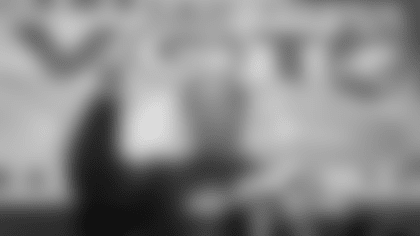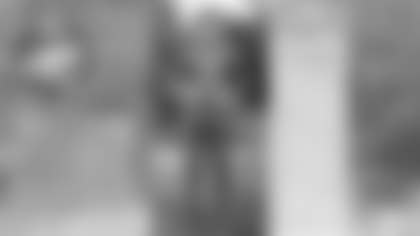Brian from Fitchburg, WI
There are early references to the Packers starting in 1918. Why haven't you bought in?
Glad you asked. And not only are you correct about those early references to 1918, but the person who wrote them was George Whitney Calhoun, co-founder of the Packers. Obviously, what he had to say can't be dismissed with anything less than overwhelming evidence to the contrary. Thus, I'm guessing that I've spent upwards of 100 hours, maybe double that, researching the subject. After all, what's more historically important for the Packers than getting our birth date and age right? Anyway, I'll try to condense my volumes of research on this subject to an answer of reasonable length and let you draw your conclusions.
First, here's what Calhoun wrote in a press release in late August 1919, within 10 days of being named manager of the Packers: "Green Bay's city football squad, holders of the Fox River Valley pigskin championship for the past two years, will play under Indian Packing Corporation colors this fall." Based on my research, at least seven papers in Wisconsin published Calhoun's release, where he actually claimed that the team had been in existence since 1917. Fast forward more than a decade and from what I've been able to determine, the Packers published a publicity pamphlet for the first time in 1930 – or what was a shorter version of today's media guide – and included a four-paragraph summary of the franchise under the headline: "Organized in 1918." That item appeared in what was an official Packers' publication through 1933 and Calhoun as their de facto publicity director presumably wrote the text for it.
Keep in mind, during those years, Calhoun wore many hats. He was city editor of the Green Bay Press-Gazette in 1919, while Val Schneider was the paper's sports columnist. Calhoun also was the manager of the Packers that year. In 1920, Neil Murphy replaced Calhoun as manager and there's no evidence that Calhoun had any connection to the team during its second season of play. Everyone from the team nurse to the water boy to the chief rooter was invited to the team's end-of-season banquet, but not Calhoun. Then on Jan. 21, 1921, Calhoun's "Cal's Comments" column reappeared in the Press-Gazette for the first time in more than two years. Although born in Green Bay and the great grandson of Daniel Whitney, the city's founder, Calhoun had spent most of his youth and early adulthood in Buffalo, N.Y. In 1915 at age 24, he returned to Green Bay when he was hired as managing editor of the Green Bay Review. In the spring of 1917, Calhoun moved to the Press-Gazette as telegraph editor and four months later assumed the added duties of overseeing the sports page when Alfred Israel, who had previously been in charge of it, volunteered to go fight in World War I. Calhoun wrote for the sports page from mid-August 1917 until mid-September 1918 when fighting in Europe intensified and he moved to the paper's news side. Once Calhoun returned to sports in the Packers' first season in what is now the NFL, he covered the team regularly and continued to write his sports column through 1925. But by the mid-1920s, if not earlier, he also was doubling again as telegraph editor. In 1928, the Press-Gazette hired Arthur Bystrom as sports editor and he covered the Packers through 1934; except Calhoun, as team secretary and a member of the Packers' board of directors, would accompany them on their annual late-season road trips and, in turn, handle the Press-Gazette's coverage. In other words, Bystrom basically covered the Packers through their early-season home games, and then Calhoun furnished the coverage and game stories on what could be month-long road trips. And what you can find is that Calhoun in his different roles would sometimes write two different things about a single subject. In the Press-Gazette's 1934 Tercentennial Edition, for example, he wrote the first lengthy history of the Packers and traced their start to 1919. Also, even in those early Packers' publicity pamphlets, he'd use 1919 as the starting point in the records section.
So why the inconsistencies? Here's some background that I think helps explain it. One, Calhoun was an inveterate organizer of sports teams, starting when he was 11 years old. In 1902, he started a baseball team in his neighborhood in Buffalo called the Elmwoods and issued a challenge to all comers in the May 23, 1902, edition of the Buffalo Evening News. By the time he was 16, he started making boasts about winning championships. When his Spartan A.C. team beat the Rumseys in a best-of-three series in February 1907, he claimed they had won the "championship for hockey of Buffalo for 115-pound teams." A year later, according to the Buffalo Technical High School annual, Calhoun organized the school's first hockey team and served as goalie and captain. The following fall as an underclassman, he was the center and manager of the school's football team and entrusted with the responsibility of securing the school's coach. When he dropped out of high school as a senior, for whatever reason, he organized the Niagara Football Team and claimed the undisputed championship of the West Side when the season was over. A year later, when the manager of an opposing team questioned Niagara's claim to a championship, Calhoun wrote a sharp rebuttal that appeared in at least two Buffalo newspapers, the Enquirer and the Commercial, on Oct. 8, 1910. There were at least seven daily newspapers in Buffalo during that period and one can find hundreds of articles or briefs about Calhoun's family and his involvement in sports at a young age at the newspapers.com website. On Sept. 25, 1910, only days after he had turned 20 years old, Calhoun wrote a rather lengthy story that was published in the Buffalo Sunday Morning News and titled, "The Making of a Football Team: The Development of the Finished Gridiron Machine From the Raw Material of the Early Fall – An Arduous Task – How it is Done." Although he was working as a railway inspector around that time, Calhoun also selected an all-Buffalo high school football team for the Evening News. Four years later, Calhoun was named editor of a weekly magazine in Buffalo devoted to high school sports. Bottom line: It was Calhoun's schtick since he was a kid to organize teams and start making claims to past championships. His 1919 press release simply followed the pattern. The Packers struggled to fill out a schedule their first season and my impression is that Calhoun tried to entice potential opponents with the idea that Green Bay's new football team actually had a history of success, even if it didn't.
Within months after being hired by the Press-Gazette in 1917, Calhoun picked up where he left off in Buffalo and started organizing teams and promoting games in several sports, but most notably football. In November 1917, he organized a Green Bay All-Stars team with the help of Jim Coffeen and promoted its only game as a Red Cross fundraiser and the "first touch of semi pro football in Green Bay." The All-Stars beat the Marinette Badgers, 27-0, with four 1919 Packers on the team, including Curly Lambeau. Less than a month later, Calhoun organized and promoted what he billed as the state high school football championship – more than a half-century before there were official playoffs in Wisconsin – between Marinette and Watertown. What Calhoun called the "greatest high school football game ever played in this city," as part of his promotional effort drew roughly 400 fans, well below the estimated 4,000 to 5,000 that had filled the old baseball stands at Hagemeister Park for recent Green Bay East-West games. In the fall of 1918, with many of Green Bay's best local high school stars from recent years fighting overseas in the final weeks of World War I and a Spanish flu pandemic raging across the nation, a local team named the South Side Skidoos beat De Pere in the first game of what the Press-Gazette called the Sunday season to distinguish it from the high school games. Lambeau played for the Skidoos, then left for Notre Dame. The next week, a team called the Whales beat Marinette with roughly half the same team that played for the Skidoos. The next week the Press-Gazette reported a meeting was held to form a "newly organized Green Bay team," or the third one in less than a month. With Art Schmaehl as coach, the Bays, as they were sometimes called, crushed Appleton, 72-0; again, with some of the same players that were on either the Skidoos or Whales or both. With Schmaehl in charge, the team held regular practices and won four straight games. Subsequently, the Press-Gazette identified Calhoun as manager of the team and began promoting it as the frontrunner to winning the Fox River Valley championship. Heading into the last game of the season, played in late November at Hagemeister Park, the paper ballyhooed it as a battle between Green Bay, claimants of the state semipro football championship, and Marinette-Menominee, champions of Upper Michigan. Although the finale ended in a 0-0 tie, Calhoun credited Green Bay with winning the state semipro title, just as he did a year earlier when the local team was victorious in its only game. Even after the Packers joined what is now the NFL, Calhoun continued to make provincial claims about the Packers being champions of Wisconsin and the Northwest, similar to what he had done in his younger years in Buffalo.
When he was wearing his promoter's hat, Calhoun was clearly more focused on hoopla and hyperbole than the facts. His claim in his 1919 press release about Green Bay winning its first title in 1917 dated to when he began his promotional efforts on behalf of a Green Bay football team and his subsequent claim about the Packers being organized in 1918 dated to when he became manager of the team.
But when you take into account that there's no other evidence of the Packers being formed before Aug. 11, 1919, and Calhoun's bent for overhyping a long line of teams starting at age 11, I feel comfortable ignoring what he wrote in a single press release and a block of text that appeared only for a few years in the Packers' publicity pamphlet. After all, the Press-Gazette in its first two stories about the history of the Packers, one published in 1922 and another in 1928, traced the start of the team to 1919. Then and as time passed, so did Calhoun. In fact, he presumably wrote the 1922 history of the team where it was stated that the Packers were in their fourth year of pro football. Then there was the come-and-go history of local amateur and semipro football in Green Bay. Are we to believe the 1-0 Green Bay All-Stars of 1917 were the first Packer team; or one of what seemed to be three different teams in 1918? What's more, there are quotes that can be found from the 1919 players about them playing for what they considered to be the original team; stories about celebrations and events through the 1960s where the 1919 team was honored as the first; and, finally, Calhoun's many references until his death in 1963 about 1919 being the start of the Packers.
I want to be clear that I'm constantly seeking to learn more about Packers history and more than occasionally feel the need to add to or revise things I've written. At the same time, I also understand there are many of what I call "cherry-picker" researchers who stumble upon a story here and there that contradicts something I've written or that others have written, but then don't seek other sources to confirm it or at least build a case to support it. That's why many authors and others have turned the early history of this great story into a muddled mess.
Todd from Appleton, WI
You recently provided details about Hagemeister Park and the ballparks there that I've never read before. Where did you find your information?
There are maps and fire atlases available at the Brown County Public Library and other county and city offices. There are old aerial and ground-level photos. There are other official documents, including leases and land records, that can be researched. I've got a copy of a 1900 catalogue published by the Brown County Horticultural & Agricultural Society that includes a history of the grounds and buildings when the park served as the local fairgrounds. At one point, I also interviewed up to a handful of people who grew up near or went to games at Hagemeister Park, some even before 1919. And, finally, I have about a three-inch thick folder of newspaper clippings about the park: When different buildings were built or razed, when some were expanded and moved, and what the buildings were used for.
I think where some authors maybe made a mistake was that they only researched stories about when the Packers played there and maybe other amateur and local football teams. Where I found some of my best information was in front-page news stories from different Green Bay newspapers; and in stories about baseball, especially when Green Bay was home to an official minor-league team from 1905-14, and about Green Bay East and West high school football. The Packers played in Hagemeister Park from 1919-22, but local baseball and high school football were much bigger in Green Bay both before then and during those four years. The same with pictures. I've learned as much from pictures of East and West football, and even one of St. Norbert College football, as I have from Packers photos from that timeframe. Some of the high school shots were what allowed me to confirm that there were wooden goal posts – not metal – in Hagemeister Park.
I've read books and articles that make it sound like Hagemeister Park barely changed in appearance from 1896 when the first baseball park was dedicated in what was then named Washington Park until the last sporting event, a Wisconsin State League baseball game, was played there on May 12, 1923. Nothing could be further from the truth. Between 1896 and 1919, the site of the ball field changed from the far southeast corner of what was called the Joannes section to where East High stands today; sheds, pens and other buildings that housed animals for the fair were torn down; a half-mile race track built in 1887 was razed in 1908; small Lake Britton, with a fountain in the center and fed by the city water works, was filled in after the race track was demolished; an Exposition building for the fair was moved from east of the race track to the Cherry Street entrance and converted into a theater, then a pavilion and later an armory; a clubhouse was constructed at the northeast corner of what is now Walnut and Baird streets and later a second floor with bowling alleys was added; and the first indoor roller rink was built in 1914 and replaced by a bigger, better one two years later. Hagemeister Park, easily accessible by boat and street car, was considered one of the most beautiful spots in Green Bay and also its most popular gathering place, so it's a fascinating story in itself. It wasn't just home to a ballpark.
I've already written about how the Packers played in three different settings during the four years they played in Hagemeister.
















